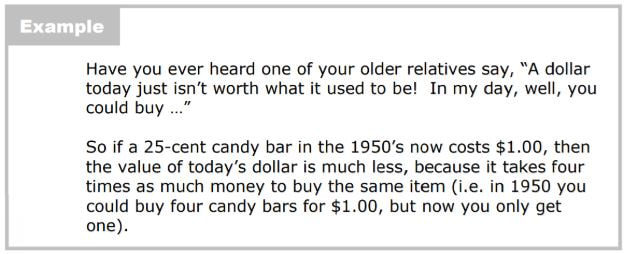Objective: Play this activity to calculate the Return On Investment (ROI) of various investment options.
About Investing & ROI
Investments are assets that you purchase or receive with the expectation that they will increase in value. The increase in value may come from periodic payments or an increase in overall value of the asset that you can sell at a higher price.
Return On Investment (ROI) is the amount that something has increased or decreased in value. It is often shown as a percentage of the original investment amount.
Example: You invest $100 and after a period of time get $110 back. This means your ROI is $10 – this is how much you earned on the investment. To convert that to a percentage, divide the amount earned of $10 by the original amount of $100 and multiply by 100% which equals a 10% ROI. This is a simple way of calculating ROI, but there are more complex methods to determine yearly rate of return and other numbers.
Example of investments
MONEY MARKET
A money market fund is an investment that pays interest while keeping the principal amount of the investment safe. Examples are Government Treasury bills (T-bills), Guaranteed Investment Certificates (GICs), and Certificates of Deposit (CD).
MUTUAL FUNDS
Mutual funds are sets of investment assets grouped into a specific fund, that is managed by investment companies or investment divisions of banks and insurance companies. A mutual fund may be set up to hold any combination of stocks, bonds, mortgages, money market instruments, and more.
STOCKS
A company can raise money by selling stock (shares). A share is a percentage of ownership in the company. People who own shares in a company are called shareholders. A company can have one shareholder or millions. Shareholders can make money on their stock by selling their shares at a higher price than they paid to buy them. Some companies also pay dividends to their shareholders. Dividends are a percentage of profits earned by the business.
BONDS
A bond is a debt instrument that is repaid in one year or more. Organizations, including companies and governments, issue bonds to raise money. By purchasing a bond, you are loaning your money to that organization. Buying a bond makes you a creditor (lender), but not an owner or shareholder, of the organization which issues the bond.
Most bonds have a stated rate of interest, called the coupon rate, which is paid for the life of the bond. Upon maturity, the organization that issued the debt repays the amount stipulated on each bond. This amount is called par value, or face value.
PRECIOUS METALS
Gold, silver and other precious metals are traded as investments. These investments can be held in the form of bullion (the actual metal) or certificate of ownership. They are often traded on world markets, and prices fluctuate with worldwide demand and availability. Some investors purchase precious metals because they believe there are both the potential for an increase in value and a reduced risk of losing their investment, because of the intrinsic value of the metal itself.
CRYPTOCURRENCY
Cryptocurrency is like paper money but in digital form. A cryptocurrency is a digital asset designed to work as a medium of exchange that uses strong cryptography to secure financial transactions, control the creation of additional units, and verify the transfer of assets. Cryptocurrency is used to pay for goods and services and is traded on currency markets. As the value of your cryptocurrency increases, you are able to buy more goods and services or you may be able sell your currency to another investor for a higher price than you paid for it.
REAL ESTATE
Rental property is a form of investment. Rent is a fixed, periodic payment made by a tenant or occupant of a property to the owner for the possession and use of the property. You can earn rent by owning and renting an apartment or house or leasing a commercial property. Your real estate holdings may also increase in value, allowing you to sell the real estate at a higher price than you paid to purchase and maintain the property.
Inflation
When determining the ROI to be gained on an investment, you should also consider how Inflation may affect your overall ROI.
The time value of money means, in part, that the worth of money changes over time. As time passes, each dollar will usually buy less and less value. This is called inflation. As the prices of goods rise over time, a dollar in the future will not buy as many goods as it does today.
Investments are assets that you purchase or receive with the expectation that they will increase in value. The increase in value may come from periodic payments or an increase in overall value of the asset that you can sell at a higher price.
Return On Investment (ROI) is the amount that something has increased or decreased in value. It is often shown as a percentage of the original investment amount.
Example: You invest $100 and after a period of time get $110 back. This means your ROI is $10 – this is how much you earned on the investment. To convert that to a percentage, divide the amount earned of $10 by the original amount of $100 and multiply by 100% which equals a 10% ROI. This is a simple way of calculating ROI, but there are more complex methods to determine yearly rate of return and other numbers.
Example of investments
MONEY MARKET
A money market fund is an investment that pays interest while keeping the principal amount of the investment safe. Examples are Government Treasury bills (T-bills), Guaranteed Investment Certificates (GICs), and Certificates of Deposit (CD).
MUTUAL FUNDS
Mutual funds are sets of investment assets grouped into a specific fund, that is managed by investment companies or investment divisions of banks and insurance companies. A mutual fund may be set up to hold any combination of stocks, bonds, mortgages, money market instruments, and more.
STOCKS
A company can raise money by selling stock (shares). A share is a percentage of ownership in the company. People who own shares in a company are called shareholders. A company can have one shareholder or millions. Shareholders can make money on their stock by selling their shares at a higher price than they paid to buy them. Some companies also pay dividends to their shareholders. Dividends are a percentage of profits earned by the business.
BONDS
A bond is a debt instrument that is repaid in one year or more. Organizations, including companies and governments, issue bonds to raise money. By purchasing a bond, you are loaning your money to that organization. Buying a bond makes you a creditor (lender), but not an owner or shareholder, of the organization which issues the bond.
Most bonds have a stated rate of interest, called the coupon rate, which is paid for the life of the bond. Upon maturity, the organization that issued the debt repays the amount stipulated on each bond. This amount is called par value, or face value.
PRECIOUS METALS
Gold, silver and other precious metals are traded as investments. These investments can be held in the form of bullion (the actual metal) or certificate of ownership. They are often traded on world markets, and prices fluctuate with worldwide demand and availability. Some investors purchase precious metals because they believe there are both the potential for an increase in value and a reduced risk of losing their investment, because of the intrinsic value of the metal itself.
CRYPTOCURRENCY
Cryptocurrency is like paper money but in digital form. A cryptocurrency is a digital asset designed to work as a medium of exchange that uses strong cryptography to secure financial transactions, control the creation of additional units, and verify the transfer of assets. Cryptocurrency is used to pay for goods and services and is traded on currency markets. As the value of your cryptocurrency increases, you are able to buy more goods and services or you may be able sell your currency to another investor for a higher price than you paid for it.
REAL ESTATE
Rental property is a form of investment. Rent is a fixed, periodic payment made by a tenant or occupant of a property to the owner for the possession and use of the property. You can earn rent by owning and renting an apartment or house or leasing a commercial property. Your real estate holdings may also increase in value, allowing you to sell the real estate at a higher price than you paid to purchase and maintain the property.
Inflation
When determining the ROI to be gained on an investment, you should also consider how Inflation may affect your overall ROI.
The time value of money means, in part, that the worth of money changes over time. As time passes, each dollar will usually buy less and less value. This is called inflation. As the prices of goods rise over time, a dollar in the future will not buy as many goods as it does today.
In terms of investing money, if you invested a dollar today and only got one dollar back 50 years from now, you are likely to lose value in terms of your buying power. Fifty years from now you might need $5 or $10 to keep the same buying power.
How to Play
How to Play
- Enter values for each of the items. The BUY field is how much you paid for an investment. The SELL field is how much you sold the investment. If the SELL amount is higher than the BUY amount, then you will see a positive ROI, otherwise it will be zero or negative. For BONDS and MONEY MARKET, the BUY and SELL amounts are the same and you can enter the INTEREST earned on the investment.
- Review the numbers and experiment with INFLATION and other values to see how the ROI changes.
- Use the PRINT button to print to paper or save as a electronic file (pdf). Write your name down on the printout if you will be submitting to an instructor.
- Use the RESET button to erase your data or start over.
|
PRACTICE
Click the PLAY ACTIVITY button below to do the activity for MO and then for yourself. Mo Money Play this activity to determine the ROI for Mo Money, based on his future investing. Experiment with different years and inflation amounts to see how the ROI changes. Review the MO MONEY PROFILE. YOUR TURN! Complete your own INVESTING & ROI activity. |




